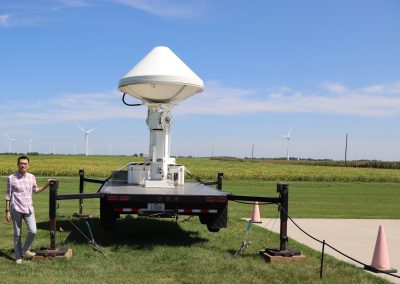Wind farms extract momentum from the atmospheric boundary layer while also generating turbulence and enhancing mixing. These affects can affect fluxes of energy, heat, and scalars (e.g. pollutants) at the land or ocean surface. Wildlife may also be affected by interacting with turbines and impact by wind turbine blades.
With a team from the Dept. of Electrical and Computer Engineering led by Professor Anton Kruger, we are developing artificial intelligence/machine learning tools that advance monitoring systems that identify species flying in the vicinity or colliding with wind turbines to help predict species behavior and develop strategies to avoid wildlife impacts.
Developing a ballistic model framework for prediction of bat fate after impact with wind turbine blades

A large number of bat fatalities have been reported in wind energy facilities in different parts of the world. The wind farm operators are required to monitor bat fatalities by conducting carcass surveys at wind farms. Our research proposes a framework of mechanics-based ballistic model to quantify the carcass search radius around wind turbines incorporating turbine operational and meteorological variables and validating an improved ballistic model with the carcass survey data. Due to lack of available data on the aerodynamic properties of bat carcasses, we conducted a study to measure bat carcass drag coefficients for various species after impact with turbine blades (Prakash and Markfort (in review)).
Developing strategies for monitoring bat activities in wind farms and interactions with turbine rotors

To reduce wind farm impacts on bats, we are exploring methods for monitoring how bat behavior is affected by environmental variables, including temperature, rainfall, atmospheric pressure, and wind. Low wind speed regions within wind turbine arrays may pose particular risk as bats often are observed approaching turbines from within the wake region where windspeeds may be more favorable for bats. Using analytical wake models, X-band Doppler radar, and thermal cameras, we track the behavior of birds and bats at landscape and individual turbine scales, improving our understanding of bat behaviors near turbines and guiding new smart curtailment strategies. By understanding how the behavior of birds and bats relates to local atmospheric conditions in and around wind farms, we are developing improved prediction and mitigation measures to minimize risk to wildlife while maximizing wind power generation through enhanced wind plant control.
Team members and collaborators: Shivendra Prakash, Jian Teng, Bingchun Huo, David Wu, Jim Niemeier, and Anton Kruger
